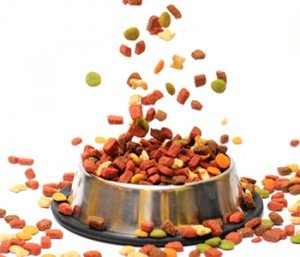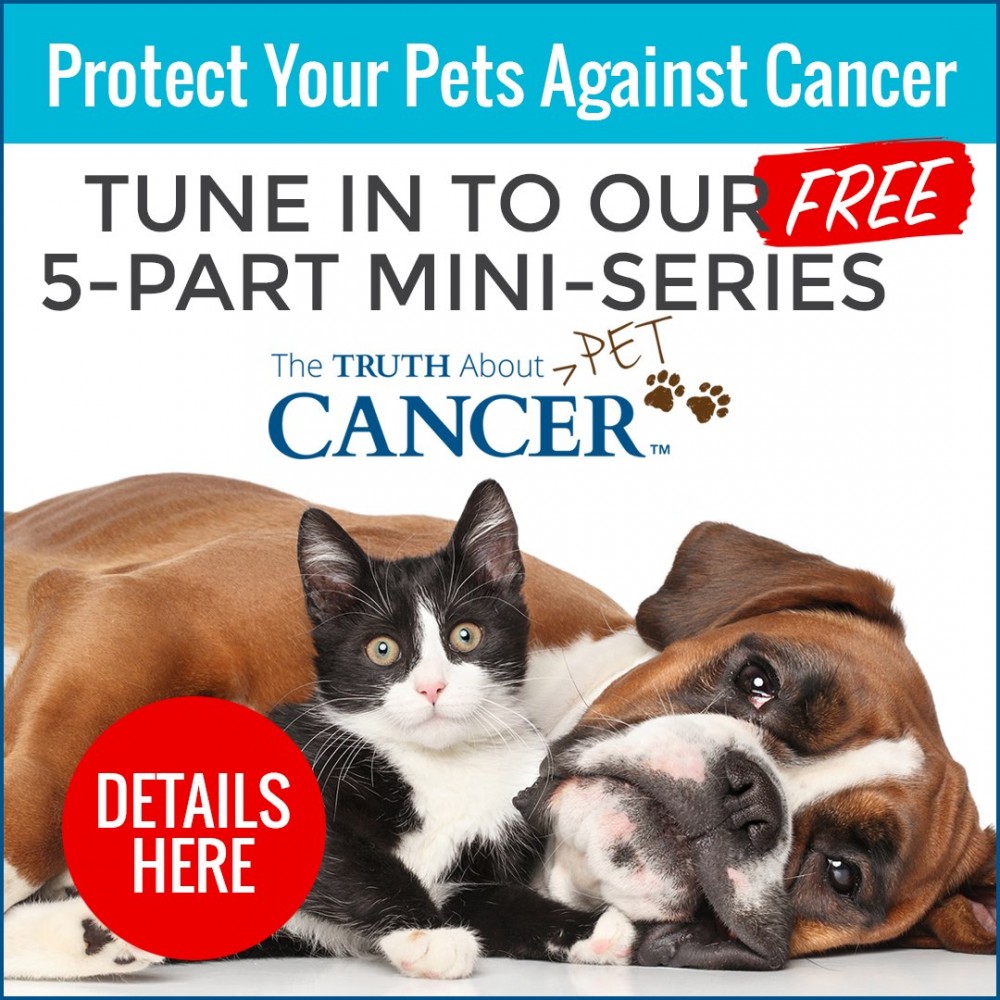Natural Approaches for Preventing & Treating Cancer in Dogs and Cats
Editor’s Note: This article first appeared in the Dec 2016 edition of TTAC’s Heroes Against Cancer member newsletter
For many of us, our pets are just as much an integral part of the familial clan as our parents or children. So when it comes to taking care of our families, we mustn’t forget the health of our furry friends.

There are approximately 12 million diagnosed cases of canine and feline cancer in the U.S. every year
Cats and dogs develop cancer at nearly the same rate as humans. There are roughly 12 million new cases of the disease between the two species every single year in the U.S. Yet many pet owners fail to consider cancer prevention in the same precautionary terms for their cuddly companions as they do for themselves and other loved ones.
Proper diet, clean water, supplementation, and regular exercise are now widely recognized as vital components of a well-rounded, cancer-preventative lifestyle for people. But how many pet owners know how to engage the same standards for their pets?
How many people know how to hand-select quality, toxin-free food for their feline and canine friends, for instance? How many of them know which herbs and nutritive compounds best help pets avoid developing tumors? Or how about what to do in the unfortunate event that your cat or dog develops cancer… what then?
These are all considerations which my family has had to grapple with concerning our own pets, and perhaps you’re in the same boat. After poring over the available scientific data to determine how best to care for our beloved companion animals, I’ve determined that there are a number of things we can all do to help our pets avoid that much-feared diagnosis. I’ve also dug up some of the best natural remedies for treating pet cancer after it’s been diagnosed. I hope you’ll never have to use it, but at least you’ll have the information at your disposal in case you do.
Common Types of Feline and Canine Cancers
According to “Fetch A Cure,†a non-profit organization devoted to teaching pet owners the ins and outs of how to avoid and deal with pet cancer, dogs are more prone to developing cancer than cats. In fact, cancer is currently the leading cause of death in dogs (excluding euthanasia by humans for various reasons). The number of feline deaths due to cancer is lower than with dogs, but not far behind. There are nearly 100 types of animal cancers, including many of the common culprits in humans: cancers of the skin, bones, head, neck, lymph, abdomen, and testicles, as well as both blood and mammary cancers.
Skin tumors are the most common form of cancer in dogs, accounting for roughly one-third of all cases. Among these, as many as 20% manifest as mast cell tumors, while the rest show up in the spleen, liver, and bone marrow. Roughly half of all skin tumors in dogs show up on the central parts of their bodies, while approximately 40% emerge on the limbs. The remaining 10% or so show up on the head or neck.
Oddly enough, skin cancer in dogs is usually benign, while in cats it’s typically malignant – though cats are considerably less prone to developing skin cancer than dogs. What cats and dogs have in common, however, is that both animals become much more prone to developing cancer the older they get – something that can’t be avoided. But as you’ll see throughout this article, there are a number of contributing disease factors that can be averted.
The Good, the Bad, and the Ugly of Pet Food Products

Many pet foods are made with ingredients that do not promote optimal health
The first and perhaps most obvious cancer risk factor is pet food. Most commercially available pet food is loaded with ingredients that run contrary to what cats and dogs need for proper nutrition. These packaged pet foods includes things like genetically modified corn and wheat gluten that aren’t easily digested, and that in many cases go against the grain of proper animal nutrition.
Heavy processing combined with the use of added preservatives, fillers, and food dyes makes the situation even worse – contributing to chronic health problems like obesity, periodontal disease, diabetes, arthritis, and of course cancer.
While convenient, much of the commercial animal food sold as either dried kibble or “wet†food in cans is toxic for pets. Generally speaking, animals both domesticated and wild perform their best on a raw food diet composed of primarily meat and vegetables – not processed grains, rendered fat, and chemical preservatives which are commonly found in many commercial animal food products.
Dr. Patrick Mahaney, a Los Angeles-based veterinarian and veterinary acupuncturist, warns that nearly all commercial pet food is made from substandard “feed-grade†ingredients as opposed to human-grade. Feed-grade ingredients are legally allowed to contain all sorts of questionable contaminants that, if many pet owners knew they were present, would likely switch to other forms of nourishment. These offending substances include:
- Mycotoxins, a poisonous byproduct of fungal mold growth that often forms on grains and seeds. The Food and Agriculture Organization of the United Nations (FAO) says exposure to mycotoxins like aflatoxins and fumonisins represents a serious health risk in animals that can lead to the formation of both acute and chronic diseases, including immune disorders and cancer.
- Animal byproducts, or the parts of slaughtered animals left over after the parts for human consumption have been removed. Besides the ick factor of many of these remains (e.g. hooves, heads, and manure), animal byproducts often contain residues of pharmaceuticals like pentobarbital, an anesthetic drug used to euthanize animals.
- Synthetic chemical preservatives, including substances like Butylated Hydroxyanisole (BHA), Butylated Hydroxytoluene (BHT), Propylene Glycol (PG), and Ethoxyquin. BHA and BHT are both known carcinogens and reproductive toxicants that are added to pet food to keep it “fresh.†Ethoxyquin is so harmful that it’s illegal to use in human food, but it’s a common ingredient used in dried pet food, especially varieties that contain “fish meal.â€
- Artificial colors, which are typically petroleum derivatives. Dyes like Yellow #5 and Red #40 are known contributors to hypersensitivity, behavioral problems, and cancer. Caramel color is likewise problematic, especially in animals because it contains a chemical known as 4-methylimidazole (4-MIE) that’s a scientificallyproven animal carcinogen.
- Rendered fat, a flavor-enhancer that’s often contaminated with microorganisms, heavy metals, and other toxins. Rendered fat is also a common source of mycotoxins, which forms when too much moisture is present.
- Carrageenan, a common additive in “wet†pet food that’s been shown to provoke an inflammatory response in animals. The International Agency for Research on Cancer (IARC) admits that carrageenan is a “possible human carcinogen,†and recent research conducted by The Cornucopia Institute (CI) identified this likely cancer-causing ingredient in roughly 70% of canned pet food products.
- Pea protein meal, a cheap replacement for actual meat that lacks the complete spectrum of health-promoting amino acids. Unless a pet food product containing this ingredient also contains either meat, rice protein, or some other source of all 20 amino acids, pets that eat it will likely develop nutrient deficiencies that could eventually lead to chronic disease and cancer.
Certified organic pet food products are preferable to most conventional and commercial options, though even some of these contain questionable ingredients like carrageenan. You need to always read the ingredients label. At the same time, certified organic pet food cannot legally contain genetically-modified organisms (GMOs), synthetic chemicals, pesticides and herbicides, and other toxic ingredients that are commonly added to non-organic pet foods.
Functional Anti-Cancer Meal Plan for Pets

A whole food diet of mostly meats, organs, and bones, supplemented with appropriate vegetables, is optimal for both cats and dogs
Since diet is probably the biggest determining factor in animal cancer risk, it’s important to feed your pets the types of foods that support their immune systems and jive with what their bodies need nutritionally. Many experts who’ve studied animal dietary patterns in the wild agree that a whole food diet composed of mostly meats, organs, and bones, supplemented to a much lesser extent with vegetables, is the way to go for both cats and dogs. Preparing this type of food at home from fresh ingredients can be both efficient and cost-effective.
Generally speaking, the proper nutrient ratio for dogs is about 75 percent meats, fats, organs, and bones, and 25 percent vegetables. For more active dog breeds, the ratio of protein to carbohydrates can be adjusted to include more veggies – these being complex carbs that will provide extra energy. It’s important to remember, though, that all dogs do best with complex carbohydrates in the form of fresh produce rather than simple carbohydrates in the form of cheap grains and starches.
Cats are a little more carnivorous. Their ratio leans more heavily on the protein end of the spectrum, ideally constituting about 88 percent meats, fats, and organs (bones are bad for cats) and 12 percent vegetables. For both cats and dogs, it’s important to always serve them the freshest meats and produce for maximum health benefits, though dogs can get away with eating meat products that are slightly less-than-fresh. Within the confines of affordability and accessibility, it’s best to stick with grass-fed, chemical-free, and organic varieties whenever possible.
Human Foods That Are Bad for Cats & Dogs
It’s also important to avoid feeding your pets certain problematic foods that might be healthy for people, but that aren’t good for them based on their respective species. For cats, these problematic foods include onions, garlic, and chives, all of which deplete feline red blood cell counts and possibly lead to anemia. Dog food, grapes, raisins, tuna, dairy products, raw eggs, xylitol, bread, and chocolate, are also on the no-no list for cats.
For dogs, the list is much the same with the addition of apple seeds, avocado, cooked bones (raw bones are just fine), candy, cat food, coffee, raw fish – other forms of clean, raw meat are fine for dogs – hops, macadamia nuts, mushrooms, rhubarb, tomato leaves, and sugar.
If making your own pet food at home isn’t feasible, prepared frozen, freeze dried, and dehydrated whole food meals are now widely available, as are high quality canned and bagged food options that are free of offending ingredients. The Cornucopia Institute has created an official “Pet Food Guideâ€Â to help pet owners make the best choices when buying packaged or prepared pet foods.
Turmeric and Other Herbs for Keeping Pets Healthy
In addition to a whole food diet, you can also feed your pets supplemental nutrients to better their chances of living a long, disease-free life. One of these nutrients is turmeric, which is both anti-inflammatory and anti-tumoral. Adding turmeric to your dog or cat’s diet can be as simple as sprinkling a bit of powdered turmeric onto their food (adjusted according to the size of the animal), or mixing it into their meat and vegetables.
It’s important to note, too, that commercial turmeric supplements high in curcumin (sometimes over 95%) aren’t the best choice for pets. Australian vet Dr. Doug English recommends opting for the whole form of turmeric (turmeric root), or a turmeric mixture called “Golden paste†when administering turmeric to your pets as these forms contains less curcumin which has never been safety tested in animals at unnaturally high levels.
Dr. English’s own successes with administering turmeric to sick animals at his clinic are numerous, and include effectively treating inflammatory conditions of the skin, allergies, atopy (tendency to develop allergic diseases), arthritis, infections, age degeneration, and many different types of cancer. Dr. English also points to evidence in the scientific literature that backs turmeric as an effective treatment for immune disorders, neuro-degeneration, irritable bowel conditions, liver disease, and uveitis in equine.
Additional beneficial, anti-cancer nutrients for pets include:
- Milk thistle, a powerful liver-cleansing tonic that studies show is effective at preventing hepatitis, jaundice, parvovirus, and leptospirosis.
- Dandelion root, a nutrient-dense “weed†that supports healthy digestion, kidney function, and immunity. Research shows that dandelion root is also helpful in preventing and treating arthritis, kidney stones, congestive heart failure, and gallbladder inflammation.
- Echinacea, a potent immune tonic that functions as a natural antibiotic to kill harmful viruses, bacteria, fungi, and protozoa. It also boosts the immune systems of animals so they’re less prone to catching “bugs†like kennel cough. Just be sure to cycle echinacea on and off to avoid creating resistance.
- Astragalus, another powerful immune tonic with strong antiviral properties. A strong antioxidant with antibacterial and antiinflammatory properties, astragalus works well with other immune-boosting herbs like calendula to promote healing.

Regular physical activity has numerous health benefits for pets… and their people!
It’s also vitally important that your pets always have access to clean, purified water, and that they spend quality time each day playing fetch, playing with toys, running, or otherwise getting regular exercise. Avoid using plastic containers when feeding or watering your pets; minimize the number of vaccinations they receive; and avoid the use of pesticides, herbicides, and other chemicals in and around your property to lessen their toxic load.
Natural Remedies for Treating Pet Cancer
Even in the event that an animal already has cancer, the aforementioned dietary and lifestyle recommendations are still highly relevant. But sometimes these methods aren’t enough on their own to completely dissolve a tumor or bring a very sick animal back to optimal health – especially if the cancer is already too far along or has metastasized. In cases like this, more intense treatment methods may be necessary.
The good news is that chemotherapy and radiation aren’t your only treatment options. The following methods, many of which are also effective in treating human cancers, are among the safest and most efficacious protocols for reversing pet cancer and producing a clean bill of health:
- The Kelmun Protocol
This simple anti-cancer remedy involves administering just two ingredients: aluminum-free baking soda and grade B maple syrup. This highly alkaline protocol (cancer cells thrive on acidity) has been shown to shrink tumors by luring sugar-loving cancer cells towards the maple syrup, only to send in the sodium bicarbonate “Trojan Horse†to destroy them.
Preparation for Kelmun involves mixing one part baking soda to four parts maple syrup and heating it to a high enough temperature to completely emulsify the two ingredients without burning them – typically around 120 degrees Fahrenheit. Kelmun works well on its own, and can also be combined with other natural treatment methods that require an “alkaline protocol,†though you should only use one alkaline protocol at a time.
The proper dosage of Kelmun for pets over 60 pounds is one teaspoon of baking soda (four teaspoons of mixture). For pets under 60 pounds, reduce dosage proportionally.
- Essiac Tea
This medicinal tea blend is commonly used to treat human cancers, but it’s also beneficial in pets. A combination of burdock root (Arctium Iappa), slippery elm bark (Ulmus Fulva), sheep sorrel (Rumex Acetosella), and Indian rhubarb root (Rheum Officinale), Essiac tea can be safety administered to animals with cancer in the following doses:
– In pets between 15 and 40 pounds: 1/2 ounce of tea, twice/day
– Between 40 and 80 pounds: 1 ounce of tea, twice/day
– Over 80 pounds: 2-3 ounces of tea, twice/day
You can find the recipe and instructions for making Essiac tea on The Truth About Cancer website. You can also purchase the tea online. Starwest Botanicals is a good source for purchasing organic, wildcrafted Essiac tea in bulk. Another great source is through the store on the Cancer Crackdown website.
- Cannabis Oil
Many pet owners are turning to potent extracts of cannabis, usually in the form of oil to treat their sick animals. Canadian researcher Rick Simpson’s “Phoenix Tears†cannabis formulation is one example of this. The late Dr. Douglas Kramer, a Los Angeles-based “mobile†veterinarian who helped pioneer the use of medical marijuana as a treatment for ailing pets, saw many of his animal patients recover from all sorts of conditions after being administered medical marijuana – including in the eradication of cancer tumors.
Traditional cannabis oil is composed primarily of tetrahydrocannabinol, or THC, the psychoactive element in cannabis that many people use to treat pain or stimulate appetite. But there’s also the cannabidiol, or CBD, component to cannabis that holistic veterinarians like Dr. Rob Silver believe are equally, if not more, beneficial for healing than just THC alone.
One such product high in healing CBD is Canna-Pet, an oil concentrate made from organic, chemical-free industrial hemp. It contains eight additional healing cannabinoids besides CBD, as well as over 20 different terpenes. Terpenes are the fragrant components of the plant that act synergistically with both each other and the full profile of cannabinoids to perform of host of therapeutic functions. Not the least of which include targeting cancer cells!
As with humans, the list of alternative pet cancer treatments is extensive. Discover how pet cancer experts and holistic integrative veterinarians are saving animals from cancer with natural cures, therapies, and treatments your average vet doesn’t even know about…





'Natural Approaches for Preventing & Treating Cancer in Dogs and Cats' has no comments
Be the first to comment this post!